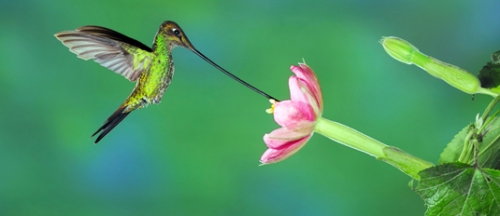Escape from an evolutionary cul-de-sac

Passion flowers with long nectar tubes depend entirely on the sword-billed hummingbird for pollination. However, as a new study by LMU researchers shows, the evolution of even such extreme specialization is by no means irreversible.
The blossoms produced by the many species of passion flowers belong to the most visually striking and attractive flowers known in the plant kingdom. Among the characteristic features of the flowers of the Tacsonia subgroup of the genus Passiflora are their extremely elongated nectar tubes. As a result, pollination in this group is wholly dependent on a single species of bird – the sword-billed hummingbird Ensifera ensifera. With its approximately 11-cm bill, which harbors a correspondingly long tongue, Ensifera is the only species of hummingbird that is capable of reaching and sampling the nectar at the bottom of the passion flowers' 6- to 14-cm long nectar tubes. As it does so, the bird's head inevitably comes into contact with the pollen grains, transports these to the next passion flower and pollinates it. Because passion flowers are incapable of self-pollination, this is the only means of pollination available to them.
"This highly specialized mode of pollination is the result of a process of coevolution," says LMU's Professor Susanne Renner. "Such highly specialized adaptations need time to evolve, and this has led to the notion that their evolutionary trajectory is set in the direction of further refinement and can never be reversed." But, it turns out, evolution is no one-way street. By applying molecular phylogenetics and a so-called molecular clock, Renner and her colleagues Stefan Abrahamczyk (now at the University of Bonn) and Daniel Souto-Vilarós were able to show that the dependency of Tacsonia species on Ensifera ensifera for pollination has been lost several times over the course of a relatively brief period, geologically speaking.
Evolution can go into reverse
The idea behind the molecular-clock method is that the degree of difference between genes descended from the same ancestral sequence (orthologs) in a given pair of species reflects the time elapsed since they last shared a common ancestor. In other words, the earlier the date of divergence, the greater the extent of genetic difference between them. This releative genetic distance can be translated into time, for example million years, with the help of an external calibration. "We have examined gene sequences from a total of 43 species belonging to the Tacsonia species group" Abrahamczyk explains. "The set included 26 species with extremely long nectar tubes and 17 species with shorter tubes. Thirteen of the latter are pollinated by short-billed hummingbirds, while bats do the job for the other four." On the basis of an analysis of orthologous gene sequences in these species, the researchers were able to deduce the order and timing of branching events (speciation) over the course of Tacsonia evolution, thus revealing when and from which possible ancestral forms new species were derived.
This reconstruction of evolutionary history indicates that the first Tacsonia species with long nectar tubes appeared around 11 million years ago. Whether the precursors of these early long-tubed passion flowers were pollinated by bees or short-billed hummingbirds remains undecided at this point, but there are strong hints that coevolution with long-billed Ensifera began very early – probably very soon after the latter diverged from its short-billed sister species. The relationship is therefore of long standing. "However, within the past 2-4 million years – a very short time in evolutionary terms – some long-tubed Tacsonia species have given rise to new forms, which are pollinated not by Ensifera but either by short-billed hummingbirds or by bats," says Renner. This diversification was accompanied by a drastic shortening of the nectar tube and, in some cases, a change in the color of the flower from red – which hummingbirds can discriminate particularly well – to pale-green or whitish, to which the eyes of nocturnally active bats are attuned.
Escaping from the perils of overspecialization
The researchers believe that the switch to novel pollinators was an indirect consequence of environmental change, and that speciation was facilitated by the emergence of geographic barriers between populations, probably as a result of the uplifting of the Andes. Geologically speaking, the Andes are a young mountain range, and crucial phases in its formation occurred around the time at which the divergence of the most recent Tacsonia species began. Tacsonia species are found exclusively in the cloud forests of the Andes at elevations of between 1700 and 4000 m. At these altitudes, Ensifera is the only pollinator equipped with a tongue long enough to harvest nectar from long-tubed passion flowers.
"Ensifera is a highly effective pollinator, but being totally dependent on a single species is a potentially risky strategy. In fact, some Tacsonia species have become extinct in certain areas where their sole pollinator no longer occurs," says Renner. "That is why it is sometimes advantageous to break the highly specialized relationship with a single pollinator – and the group of long-tubed passion flowers we have studied includes good examples of such evolutionary switches."
More information: S. Abrahamczyk, D. Souto-Vilarós, and S. S. Renner. Escape from extreme specialization: passionflowers, bats and the sword-billed hummingbird. Proc. R. Soc. B November 22, 2014 281 1795 20140888; DOI: 10.1098/rspb.2014.0888 1471-2954
Provided by Ludwig Maximilian University of Munich


















